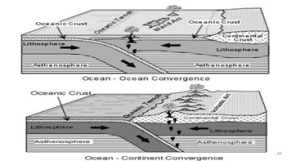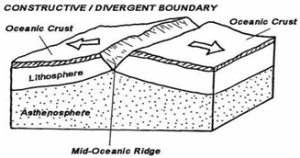Answer.
APPROACH
Introduction: Begin with the basic description of the theory, like its contributors, the preceding works which formed the basis of the theory and the basic proposition of the theory.
THE BODY
- Discuss the core highlights of the theory, bringing out its concepts, such as the division of lithosphere into plates (major and minor) and their constant movement shaping the face of the earth.
- Briefly describe three types of plate movements along with suitable examples and diagrams.
- Thereafter, address the formation of the Himalayas due to continent-continent type convergence.
Conclusion: Write the overall assessment of the theory in explaining the evolution of the earth and various phenomenon.
Introduction:
In the year 1967, McKenzie, Parker and Morgan made independent contributions in proposing the Plate Tectonics Theory as an improved version of Wegner’s Continental Drift Theory. The concept of seafloor spreading provided the base for this theory which presents the view that the lithosphere comprises tectonic plates which move in response to the convection currents moving in the upper mantle.
The Body-
Concept of Plate Tectonics:
- A tectonic plate is a massive, irregularly-shaped slab of solid rock which may be continental or oceanic in nature.
- The plates move horizontally over the asthenosphere as rigid units.
The theory of Plate Tectonics proposes that the earth’s lithosphere is divided into seven major and some minor plates. The margins of the plates are sites of geological activities such as subduction, earthquakes, volcanic eruption, crustal deformation, folding, faulting etc.

MAJOR PLATES MINOR PLATES
1. Antarctica and surrounding oceanic plate 1. Cocos plate
2. North American plate 2. Nazca plate
3. South American plate 3. Arabian plate
4. African plate with eastern Atlantic floor plate 4. Philippines plate
5. Eurasia and adjacent oceanic plate 5. Carolina plate
6. Pacific plate 6. Fuji plate
7. India- Australia- New Zealand plate
It is the tectonic plates which move constantly, and continents are a part of these tectonic plates. The convection currents within the asthenosphere and mantle plumes are the forces driving the motion of these plates.
Three types of motions occur between the tectonic plates, which are as follows:
1. Convergent Plate Boundaries: The convergence between two tectonic plates causes the subduction of the denser plate under the lighter plate. Such plate boundaries lead to the destruction of the crust and are, therefore, known as convergent or destructive plate margins.
Earthquakes, the formation of fold mountains, and trenches are the results of such plate movements.
An example includes the formation of the Andes when there occurs convergence of the South American plate and the Nazca plate.

2. Divergent Plate Boundaries: Such spreading margins exist where two tectonic plates pull away from each other and, as a result, form a new crust. The Mid-Atlantic Ridge, where American plate(s) diverge from the Eurasian and African plates, is a classic example of diverging plates.
Diverging or constructive plate margins are responsible for volcanic eruptions, seismic activities, formation of ridges, arc islands, rift valleys etc.

3. Transform(conservative) boundaries: When the plates move and slide past each other in a horizontal manner, the crust is neither produced nor destroyed. Thus, such plate movements with respect to each other result in strike-slip faults and earthquakes with the sudden release of energy.
Examples include the San Andreas fault, Anatolia-Arabian plates etc.

FORMATION OF HIMALAYAS:
According to the Plate Tectonics Theory, the Himalayas, one of the youngest fold mountains on the earth, represent the case of convergence of two continental plates, namely the Indo-Australian plate and the Eurasian plate.
About 70-65 million years ago, an extensive Tethys Sea existed in place of the Himalayas. This Tethys Sea was flanked by the Indo-Australian plate in the south and the Eurasian plate in the north. The northward movement of the Indo-Australian plate towards Eurasian plate other brought the plates closer to each other about 60-30 million years ago.
The collision of the Indian plate and the Eurasian plate thrust the relatively smaller Indian plate below the Eurasian plate. This convergence led to the compression and folding of sediments previously occupying the Tethys Sea and gave rise to landforms such as the Himalayas and extensive Tibetan plateau.

The scientists believe that the process is still continuing and causing the height of the Himalayas to rise even further.
Conclusion:
The plate tectonics theory is noteworthy for presenting a scientific explanation for the various types of plate motions and resultant activities like the formation of mountains, volcanic island arcs, trenches, ridges, rift valleys, earthquakes, volcanic eruptions etc. It is the most acceptable theory among the scientific community for the present distribution of continents and oceans and their evolution which is ongoing, for instance: the rise of the Himalayas.
Spread the Word
